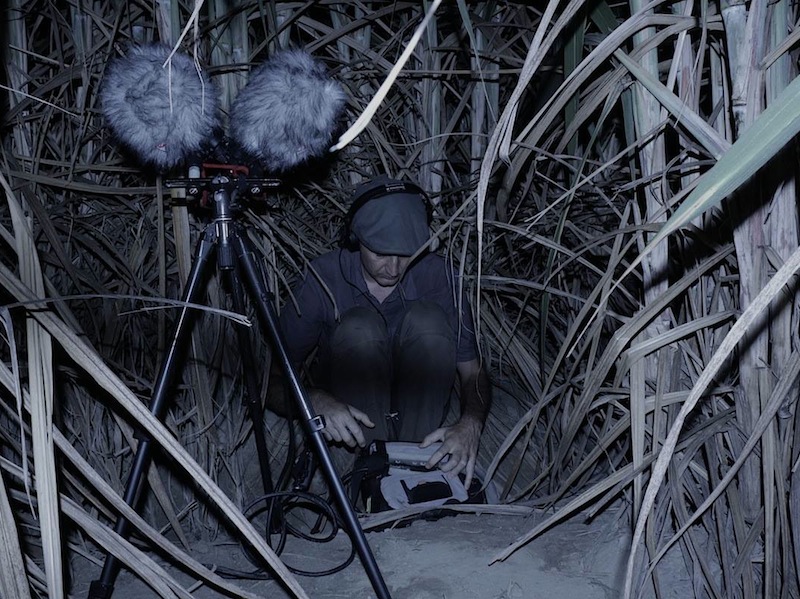Animal Music: Click, Click. Tick. Bats.

Echolocation is a stunningly inventive navigation tool. But is it also a language?
Lena Grosche has a thing for bats. Ever since her days as a student of landscape ecology, she has made them her focus of attention and today co-runs Echolot, Germany’s leading agency for bat sciences. Whenever big infrastructural projects or construction work are being planned, decision takers will call Grosche to explore the impact on the bat population. And whenever that happens, she’ll leave the house in the middle of the night with a team of colleagues and volunteers to catch a few specimens, establish data about their development and to record their chants – one of the most unique and fascinating facets of animal song on the planet.
Bats use echolocation for navigation, but they’re not the only animals to do so. Dolphins and whales in particular, as well as some rare bird species, also use more or less sophisticated forms of it. But owing to their elusive character, somewhat frightening appearance and a flowery mythology, bats have always been able to inspire the human imagination just a little bit more. For centuries, it remained unknown how they were able to navigate at night. After all, although bats aren’t actually blind, they do have rather limited eyesight. As far back as 1790, Italian priest, biologist and physiologist Lazzaro Spallanzani had come within arm’s length of solving the riddle. Spallanzani locked up an owl and a bat in a perfectly black room to observe their capacity of flying in complete darkness. While the owl would constantly bump into different objects blocking its flight path, the bat managed to stay clear of them. After a letter describing his inquiries had fallen into the hands of Swiss scientist Charles Jurine, another experiment was added to the equation: After plugging one of the bat’s ears, it was no longer able to avoid the occasional collision. His conclusion that bats were equipped with a ‘sixth sense’ and required their sense of hearing for spatialisation would prove to be correct – but Spallanzani did not yet have the means required to translate his suppositions into hard facts. It would take a full 140 years and until the arrival of a seminal figure in animal sciences, Donald Redfield Griffin, to make that happen.
More than a reflex
It was clear right from the start that Griffin was different from his colleagues. Born in New York in 1915, he was already a professor by 1942, going on to build a career that would take him to Cornell, Harvard and, finally, Rockefeller. What mainly distinguished Griffin from an earlier generation of zoologists was firstly, that he, as Raghuram/ Marimuthu put it in their essay ‘The Discovery of Echolocation’, ‘challenged the dogma that animals are mindless automatons, controlled solely by instinct and reflex.’ Secondly, he would make use of all the innovative technology he could lay his hands on to prove it, going on to make groundbreaking discoveries in the field of bird migration and the hearing facilities of fish. But nowhere would his impact be felt more strongly than in the field of echolocation. Griffin was intrigued by two articles which had appeared within close temporal proximity of each other after the Titanic disaster. The sinking of the ship had started a race for ideas to prevent a catastrophe like it from ever happening again
and in 1912, Sir Hiram Maxim suggested that one might perhaps be able to make use of the bat’s as-yet unknown ‘sixth sense’. His hypothesis consisted in the idea that ‘bats detect obstacles by feeling reflections of the low frequency sounds caused by their wing beats (appx. 15 Hz) and ships could be protected by collisions with icebergs or other ships by the installation of an apparatus to generate powerful sound and a detection device to receive the returning echoes’. Five years later, Hamilton Hartridge proposed the exact opposite, namely that bats might be using sounds of high frequency and short wavelength. Griffin was more convinced by the latter theory and would use it as a departure point for his own inquiries. It helped that physicist George Washington Pierce had already built a device capable of detecting these ultrasonic sounds, although he had actually constructed it for recording cicadas. It would take a string of experiments conducted between 1938 and 1940 until Griffin was able to fully grasp the mechanism at work – and he would pursue refining and detailing his discoveries for many years after that.
In an essay for Scientific American, Professor Alain Van Ryckegham has summed up Griffin’s findings: ‘Most bats produce echolocation sounds by contracting their larynx (voice box). A few species, though, click their tongues. These sounds are generally emitted through the mouth, but Horseshoe bats (Rhinolophidae) and Old World leaf-nosed bats (Hipposideridae) emit their echolocation calls through their nostrils: there they have basal fleshy horseshoe or leaf-like structures that are well-adapted to function as megaphones. Echolocation calls are usually ultrasonic – ranging in frequency from 20 to 200 kiloHz (kHz), whereas human hearing normally tops out at around 20 kHz. Even so, we can hear echolocation clicks from some bats, such as the Spotted bat (Euderma maculatum). These noises resemble the sounds made by hitting two round pebbles together’, Van Ryckegham writes. ‘In terms of pitch, bats produce echolocation calls with both constant frequencies (CF calls) and varying frequencies that are frequently modulated (FM calls). Most bats produce a complicated sequence of calls, combining CF and FM components. Although low frequency sound travels further than highfrequency sound, calls at higher frequencies give the bats more detailed information – such as size, range, position, speed and direction of a prey’s flight. Thus, these sounds are used more often.’ Fascinatingly, not only are bats able to produce astoundingly loud sounds of up to 120 db, which is ‘louder than a smoke detector 10 centimeters from your ear’, as Van Ryckegham notes with palpable admiration, they are also able to make astounding distinctions when processing the information. According to the author, ‘some Horseshoe bats can detect differences as slight as .0001 kHz’. It is through this combination of remarkable talents that bats are capable of navigating so precisely in the absence of daylight.

Bat detectors
What can also be concluded from these elucidations is that it is technically possible to perceive bat calls and clicks with bare ears – if standing close enough to the bats and, with regards to the directionality of the ultrasounds, in their flight path. In fact, without being aware of Griffin’s experiments, Dutch scientist Sven Dijkgraaf had arrived at the very same conclusions just by listening to bats, coining the term ‘ticklaut’ for their clicks. In practise, meanwhile, most researchers today are not using their ears, but bat detectors, modern versions of Pierce’s ultrasound apparatus, to gather the necessary data. Lena Grosche, for example, is using both portable detectors as well as more advanced stationary devices, which generate high-resolution recordings and even allow for visualisations of the echolocation information – although to Grosche, echolocation is purely an acoustic phenomenon and any graphic representation is merely an attempt to translate it to the more visually oriented human world. Japanese field recordist Eisuke Yanagisawa prefers a detector of the heterodyne-type – which is relatively cheap and simply pitches down the bat calls to a frequency range accessible to human hearing in real-time – because ‘it has good sensitivity, is easy to use and the least expensive. It seems each model has a different sound character even in the same types of detectors. I understand that the heterodyne bat detector can’t keep the original waveform as time
expansion ones do, but I don’t think the one I use completely alters the nature of the original source sound. If you listen to cicada recordings, for example, you can hear the common characteristic sounds as we hear in the audible range. And to a greater or lesser extent, recorded sounds are “interpretation” of real sounds even if you record with the “most accurate” microphones.’
So what is communicated through these sounds? According to Grosche, quite a lot, since bats have an astounding expressiveness. There are many different social calls used for interaction, although their specific content remains to be decoded. Calls used for mating, between mother and child, as well as for securing one’s territory have also been identified – in human terms, they’re communicating, as she puts it, information like ‘Get lost, this is my territory’ or ‘Come over here, you’d be perfect for my offspring’. A recent study has also suggested that tropical bats may be sending out welcome calls to each other and to confirm that they’re of the same species. But how much creativity does she see in these calls? ‘I wouldn’t say bats are creative per se. Neither have I heard of individually developed call techniques. In fact, I’m sure the techniques currently in use were developed through long evolutionary phases. On the other hand, different bat species have developed differentiated and highly specialised location systems. And just as with probably every mammal, each bat has a voice of their own. There is, for example, a certain variability within the main frequencies of a particular species. There is also some research being done into geographically different dialects.’ The latter facts may sound hopeful, yet one should never forget that echolocation significantly depends on environmental conditions. As long as there is no established method of filtering these out from the equation, extracting the communicative aspects will remain exceedingly hard. If two bats are emitting different calls, for example, they may be trying to communicate almost the same message, but adapting their calls to different situations. Even humidity can, as Grosche points out, play a role in this. Seventy years after William Griffin’s seminal discoveries, the mysteries of bat song are still far from completely resolved.
BY TOBIAS FISCHER & LARA CORY
http://www.scientificamerican.com/article.cfm?id=how-do-bats-echolocate-an
http://www.ecoobs.com
http://www.batcon.org
Donald Redfield Griffin, ‘The Discovery of Echolocation’ in Resonance Journal, Feburary 2005
Donald Redfield Griffin and Robert Galambos, ‘The Sensory Basis of Obstacle Avoidance by Flying Bats’ in Journal of Experimental Zoology Volume 86, Issue 3, pp. 481–506, April 1941






















